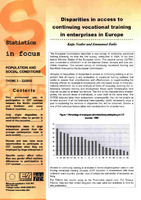Statistics in Focus: Population and social conditions. Disparities in access to continuing vocational training in enterprises in Europe. 2002.22

working document
Συγγραφέας
Nestler, Katja
Kailis, Emmanuel
Ημερομηνία
2002Προβολή/
Θεματικές επικεφαλίδες
Social Conditions ; Educational trainingΠερίληψη
The European Commission launched a new survey of continuing vocational training following on from the first survey, conducted in 1994, of the then twelve Member States of the European Union. The second survey (CVTS2) was conducted in 2000/2001 in all the Member States, Norway and nine candidate countries. This second survey of continuing vocational training was twothirds financed by the European Commission. Analysis of inequalities or disparities in access to continuing training is an important field of inquiry in any evaluation of vocational training systems that seeks to assess their selectiveness and effectiveness in supplementing the training offered, for example to employees with the lowest levels of initial educational attainment. As in any analysis of forms of inequality involving the relationship between training and employment, those under investigation here may be caused by at least two factors. The first is the characteristics of enterprises, the second those of individuals, or even both at the same time. The CVTS2 data are taken from enterprises; consequently, they do not enable us to take account of all the individual heterogeneity, which necessarily plays a part in explaining the variance in disparities that will be observed. Gender is one of the individual factors taken into consideration for analysis here
Αριθμός σελίδων
8p.Γλώσσα
ΑγγλικάΣημείωση
Downloaded from EU Bookshop.http://aei.pitt.edu/id/eprint/85325
